
![]()
By means of Kate Quinones
CNA Staff, October 27, 2024 / 6:00 AM
On her ordination day, a woman usually wears a white dress as she approaches the altar of the Lord. It looks a lot like a wedding, but her groom is Jesus Christ.
The little-known vocation of the consecrated virgin has grown in recent years. Although it existed in the early Church, it lost popularity in the Middle Ages as monasticism grew. In more recent years there has been a revival of the role since Vatican II, during which the rite was revised.
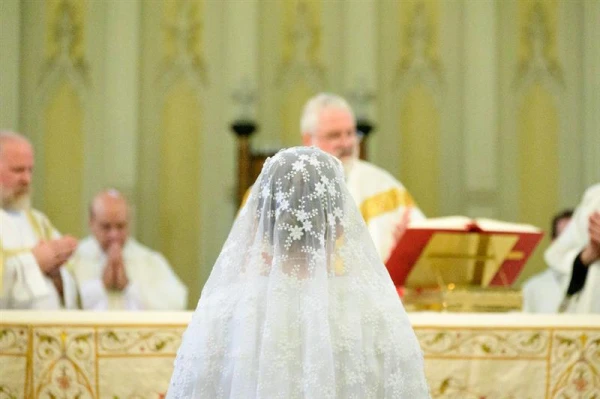 Holly Garnett was initiated into the Military Ordinariate of Canada as a consecrated virgin. Credit: Photo courtesy of Holly Garnett
Holly Garnett was initiated into the Military Ordinariate of Canada as a consecrated virgin. Credit: Photo courtesy of Holly Garnett
Today, there are more than 4,000 ordained religious women in the world – 307 of them in the United States, according to Judith Stegman, president of the US Association of Consecrated Virgins (USACV) and canon lawyer.
Since the Vatican onwards defined the role and formation of consecrated virgins in 2018, Jenna Marie Cooper, a canon lawyer, author, and consecrated virgin, has noticed that an increasing number of women are choosing to consecrate themselves to God in this way, indicating that the vocation can continue to grow in the years to come.
What is a consecrated virgin?
Today, consecrated virginity entails a committed prayer life, service to the diocese, and a “sacred decree” of celibacy. But it is also a mystical marriage to Christ and a representation of the bride of Christ, the Church.
In the ritual of dedicationthe candidate makes her sacred decision through a series of yes or no questions and is ordained by the bishop through the prayer of ordination, Cooper explained.
The ritual of a consecrated virgin is reserved only for women: religious sisters or lay women who live a life of prayer and celibacy outside a convent or monastery.
A consecrated virgin is intended as a sign of the Church as the bride of Christ. “Imagining the Church as the bride of Christ is behind this calling,” Stegman explained.
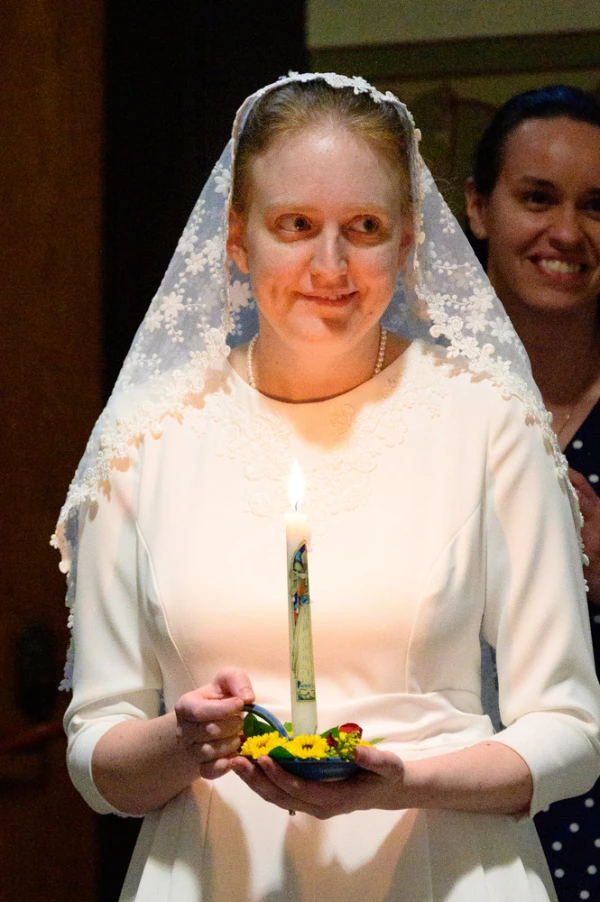 Holly Garnett is initiated into the Military Ordinariate of Canada as a consecrated virgin. Credit: Photo courtesy of Holly Garnett
Holly Garnett is initiated into the Military Ordinariate of Canada as a consecrated virgin. Credit: Photo courtesy of Holly Garnett
Women often wear a white dress similar to a wedding dress during the ceremony, symbolizing their commitment to Christ as His wife. The color white also refers to the baptismal garment, which Cooper says is “theologically appropriate.” Cooper recalled wearing her mother’s wedding dress, a simple wool garment, when she was ordained – just four days before her parents’ wedding anniversary.
“This is the response of a woman with her open heart to Jesus,” Stegman added. “She will be a bride of Christ.”
Ordination parallels the role of a priest, which is reserved for men in the Catholic Church. A priest represents “another Christ” and is a bridegroom of the Church. In the same way, a consecrated virgin represents the bride of Christ and is an image of the Church.
“This ritual is specific for women and not for men. The language is for women everywhere,” Stegman explains. “A man can take a vow of chastity, but that is different from being consecrated as a virgin bride of Christ.”
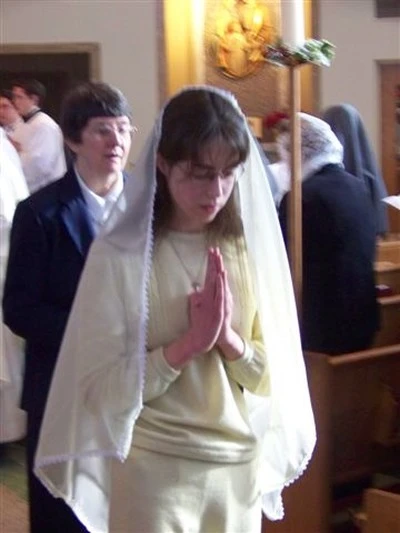 Jenna Marie Cooper, a consecrated virgin, canon lawyer and author, will be ordained on January 3, 2009. Credit: Photo courtesy of Jenna Cooper
Jenna Marie Cooper, a consecrated virgin, canon lawyer and author, will be ordained on January 3, 2009. Credit: Photo courtesy of Jenna Cooper
(Story continues below)
Subscribe to our daily newsletter
According to the Catechism of the Catholic Church, consecrated virgins “are called by the Lord to cling to Him alone with greater freedom of heart, body and mind, and have decided, with the approval of the Church, to enter into the respective states of virginity or live eternal chastity. ” (KCC, 922).
Unlike religious sisters who are attached to an order and move to wherever their superiors instruct them, a consecrated virgin is tied to a diocese. She works in mutual discernment with her local bishop, although she does not take a vow of obedience as many religious orders do.
“It’s also a prayerful presence,” Cooper explained. “Having women who are specifically committed to praying for this diocese, these priests, this local church – I think that is something very important. And it’s just a good presence for people to have women praying for them in this motherly way.”
Life requires more than just staying single. Consecrated virgins regularly participate in the Divine Office, also known as the Liturgy of the Hours, the prayer of the Church.
“We are conferred the divine office at the ordination ceremony, and the introduction to the rite specifically says that – and it is a very strong ‘should’ – we should at least pray the morning and evening prayers from the office,” says Stegman. added.
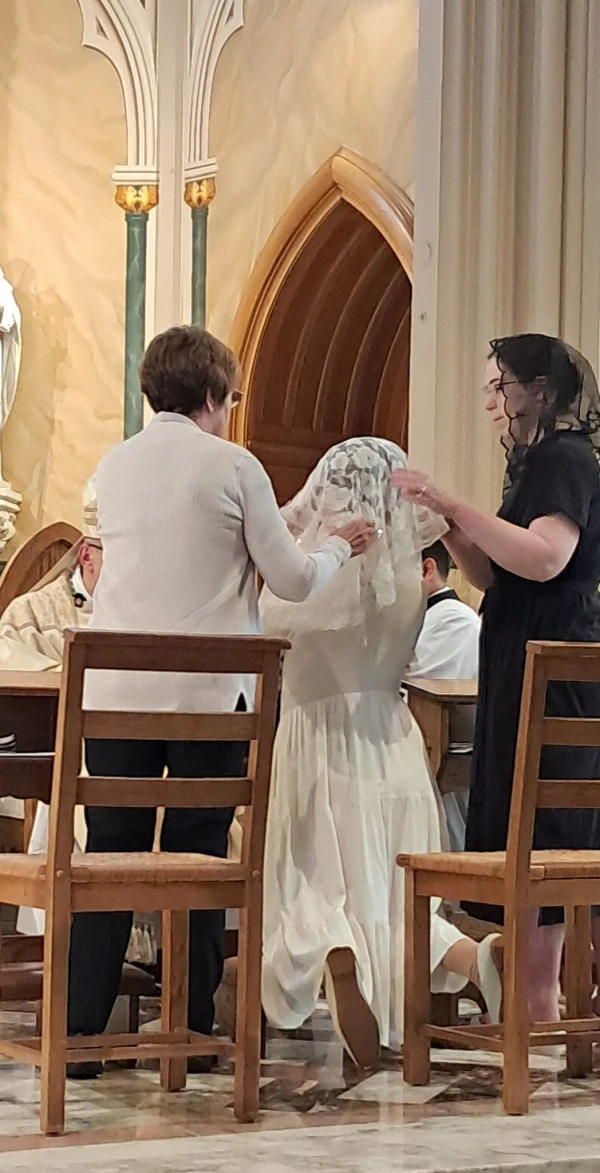 Courtney Ramsdell, a recently ordained virgin from the Diocese of Bridgeport, Connecticut, receives the veil at her ordination. Credit: Laurie Power
Courtney Ramsdell, a recently ordained virgin from the Diocese of Bridgeport, Connecticut, receives the veil at her ordination. Credit: Laurie Power
Catholic women seeking consecrated virginity must be ordained to God by their diocesan bishop. The consecration constitutes both a mystical engagement with Christ and a devoted service to the Church.
Unlike religious brothers and sisters, consecrated virgins live in a secular state of life: they have a job, do not necessarily live in community and provide for their own needs. Consecrated virgins also wear no habits and have no title. The local diocese is not financially responsible for them, and although the consecrated virgins do not take a vow of obedience, they receive guidance from their diocesan bishop.
The history of consecrated virginity
Virgin saints have existed throughout the history of the Church, and consecrated virgins existed before female religious orders were well established. Their calling is modeled to the Blessed Virgin Mary, who is their patroness. According to tradition, Mary consecrated her virginity at a young age.
Early Church Fathers such as St. Ignatius of Antioch said consecrated virgins as a separate group, dating back to about 110 AD
“When you read about early consecrated virgins, they don’t give us a blueprint for modern consecrated virgins because there are a lot of cultural differences,” Cooper explained. “But there are very early references to women being initiated with this (rite). This is still very historic.”
St. Ambrose also referred in a letter to the rite of the consecration of the virginity by the Pope, St. Marcellina, of his sister.
“When you come across more legendary saints and stories, it’s hard to say. But (for) saints for whom we know more about their lives from that time, we do have some evidence that this rite existed. So it’s actually that old,” Cooper continued.
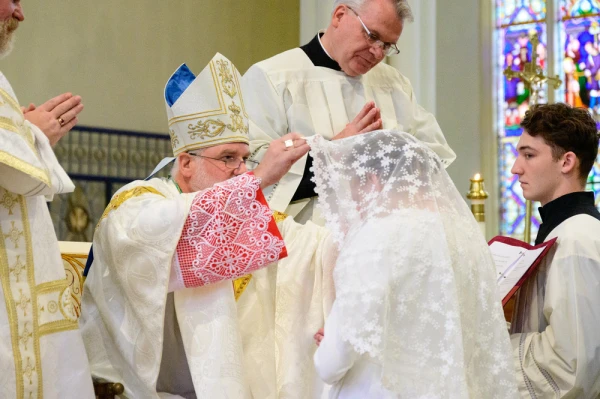 Holly Garnett is initiated into the Military Ordinariate of Canada as a consecrated virgin. Credit: Photo courtesy of Holly Garnett
Holly Garnett is initiated into the Military Ordinariate of Canada as a consecrated virgin. Credit: Photo courtesy of Holly Garnett
Some religious orders, such as the Benedictines and the Carthusians, retained the use of the ritual of consecrated virginity, Cooper explained.
“That’s why we still have the ritual, because these few religious orders still used it,” Cooper explained.
Virgin martyrs in the Roman Canon, such as Agnes, Lucy and Cecilia, are considered consecrated virgins, Cooper noted, although these women were not initiated into the rite as it exists today. A quotation attributed to St. Agnes is included in the rite of consecration.
The practice of consecrated virginity declined in the sixth century as monastic religious life became more popular. A consecrated religious life became extremely rare in the Middle Ages.
The only time consecrated virgins were not allowed by the Church was a brief period in the early 20th century, but Vatican II later announced the decision to revise the ritual of consecrated virginity in paragraph 80 of Sacrosanctum Concilium. The Church reaffirmed the vocation of consecrated virginity and then further developed its structure in 2018 in the document Ecclesiae Sponsae Imago.
“That gave us a little bit more about the way of life of consecrated virgins and what is and isn’t required of this, and a little bit about what formations would look like,” Cooper said.
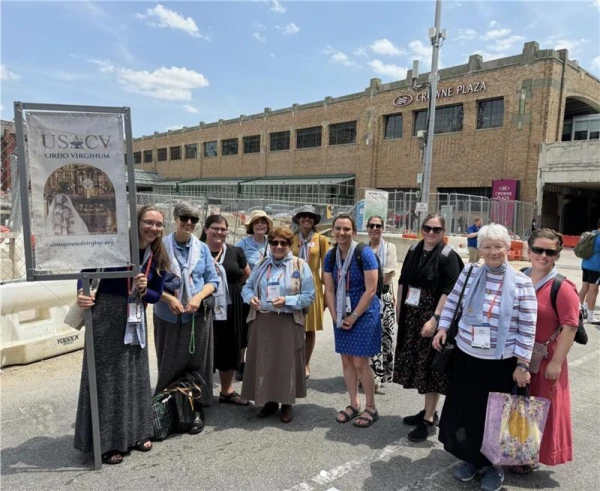 Members of the United States Association of Consecrated Virgins attended the National Eucharistic Congress as a group. Credit: American Society of Consecrated Virgins (USACV)
Members of the United States Association of Consecrated Virgins attended the National Eucharistic Congress as a group. Credit: American Society of Consecrated Virgins (USACV)
Ecclesiae Sponsae Imago helped to grow and define the calling. Cooper said that even since her own ordination in 2009, she has seen increased interest in the past five to 10 years, with more dioceses offering formation programs.
When asked what her hope was for the future of the vocation, Cooper noted that while consecrated virgins “don’t need the numbers” in the same way that religious communities might, it was “a pleasant surprise and a joy” to see the growth. of the calling.
“It’s growing much faster than I ever envisioned when I was initiated 15 years ago,” she said. “But I hope that the dioceses will really focus on good formation programs and that they will consider very carefully how to integrate consecrated virgins into the life of the local Church in a way that will promote the flourishing of all.”
“My hope is that the bishops will see the gift that this is for the Church and that they will use that gift well,” Cooper added.

Kate Quiñones is a writer for the Catholic News Agency and a member of College Fix. She has been published by the Wall Street Journal, the Denver Catholic Register and CatholicVote, and she graduated from Hillsdale College. She lives with her husband in Colorado.
Leave a Reply